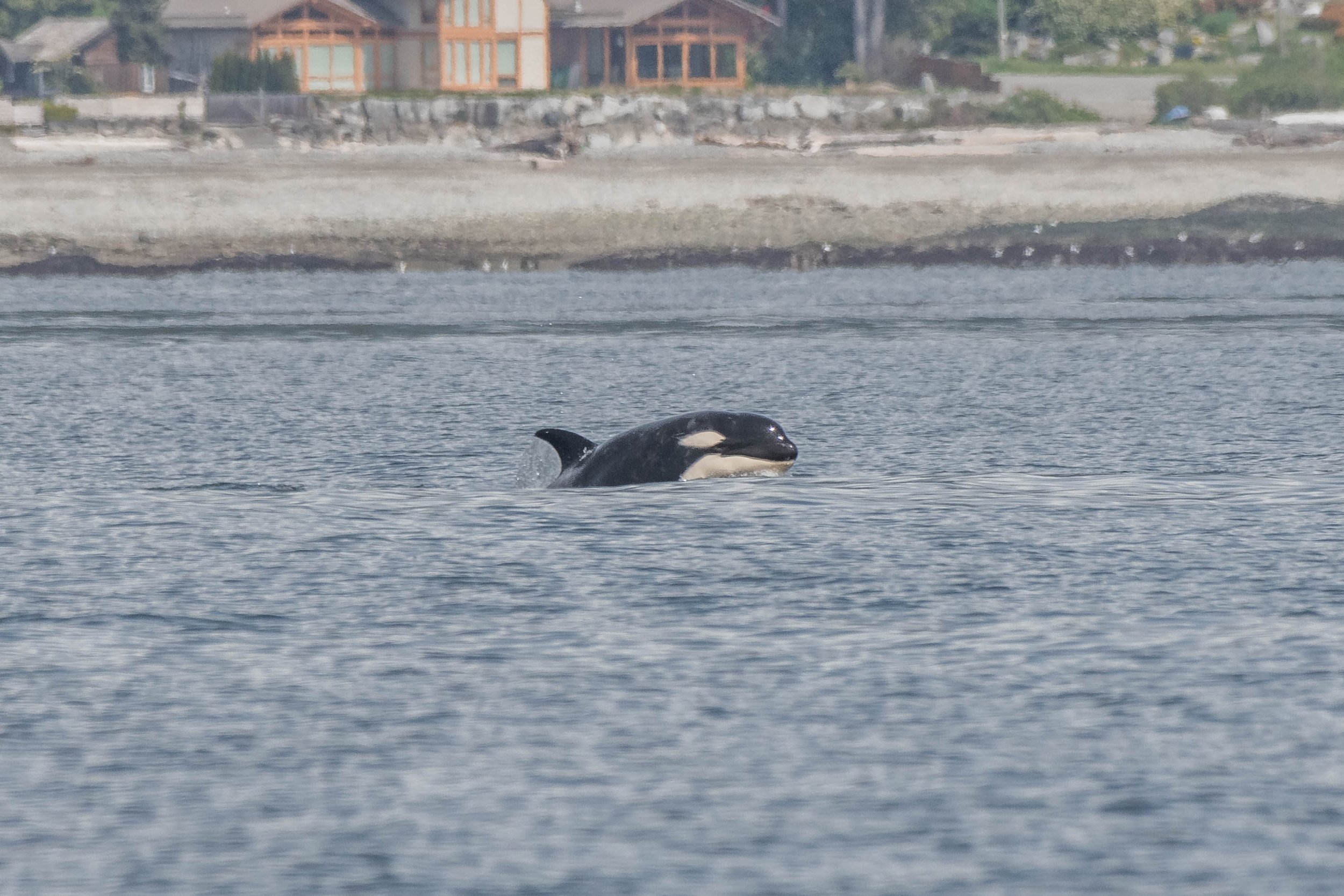April 30, 2025 - T124Ds sharing a meal
It was a fantastically sunny and calm day as we made our way from the dock towards the Georgia Strait. Conditions were perfect as we cruised over to the Sunshine Coast, where we were fortunate to encounter the T124D matriline sharing a meal together. This family includes the following members:
T124D Field ♀ (1996)
T124D1 Salish II (2014)
T124D3 (2022)
T124D4 (2024)
When we arrived, the whales had just finished hunting a sea lion; likely a Steller sea lion based on the location. This was excellent timing, as much of a hunt takes place underwater, making it rare to see the aftermath so clearly. We got to see this young family excitedly share their kill among the group. Food sharing is an important part of Orca culture, and all members of the pod get to have a meal. When there are young calves present, such as in this pod, older members of the pod will prolong the hunt so that younger members can learn and practice their hunting skills. This means that once the baby is old enough to be weaned from mom, they can participate in the family hunt. While it can be difficult to know for certain if hunts are successful or not, today was not one of those days! We were able to get photos of the matriarch Field with intestines draped over her dorsal fin, clearly enjoying her lunch. After enjoying a good meal, we started to see some excited behaviour from these guys! After feeding, the pod became playful and surface-active, which is common for Bigg’s killer whales with full bellies. Young T124D4 treated us to several spectacular breaches, leaping fully out of the water!
Field has proven that she is an excellent matriarch for her small family. A Steller sea lion is no easy prey item, and to successfully take one down takes skill, coordination and patience. Steller sea lion females can grow to 1000 pounds, and males can reach weights of over 2500 pounds! To put this into perspective, a female orca is at its largest around 6000 pounds, so she is successfully hunting an animal that can be almost half her body weight! On top of the large weight of the sea lion, they are also agile predators with large teeth. Bigg’s killer whales’ preference for seals and sea lions is often the reason we have so many nicks and notches in our whales’ dorsal fins. These notches never go away, and we can use them to identify individual animals throughout their lifetime.
If you look through our photos, you may also notice rake marks, particularly on T124D3. These are tooth marks left by other orcas. While they can leave permanent scars, they are a normal part of dolphin culture (orcas are the largest members of the dolphin family). Rake marks can result from play, dominance displays, or aggression, especially between males. In some species, like Risso’s dolphins, these marks become so prominent over time that their skin turns white with age. With orcas, rake marks don't lighten their skin, but they do help us recognize individuals, especially when they appear on the saddle patch behind the dorsal fin.
If hanging out with this wonderful family wasn’t incredible enough, we also got to hang out with a variety of other wildlife, including Steller sea lions (living ones), Harbour seals, Cormorants and even a last-minute surprise from a river otter as we pulled into the dock! You can check out the photos from our encounter below!
All photos taken by naturalist Aly Kohlman.
T124D4 surfacing for a breath
T124D3 showing off some fresher rake marks on their dorsal fin
Matriarch Field enjoying the Sunshine Coast
A head on shot of Field
T124D Field with intestines draped over her dorsal fin
The easiest way to identify T124D Field is by the scaring on her saddle patch!
A tiny tail.
T124D3 food sharing with their family
T124D1 Salish II surfacing next to her mother T124D Field
Did you know an orcas eye is located below the front part of the eyepatch? (T124D4)
A family photo from left to right T124D4, T124D1 Salish II, T124D3, T124D Field.
This orca is clearly munching on some lunch!
Lunchtime!
Did you know orca have black bodies and white bellies? This is called counter shading and is a form of camouflage.
Possibly T124D Fields tail.
T124D4 surfacing in front of the sunshine coast
Harbour seals hauling out and soaking up the sun
This little harbour seal had gotten stuck in between the rocks, but don’t worry, in the end he got out!
A Steller sea lion with a minor injury on the flipper. Do you see the nails?
A happy Steller relaxing on a sunny day
Steller sea lions stampeding into the water!
A young male Steller sea lion
A last minute river otter surprise!!
Cormorants enjoying the sun
























